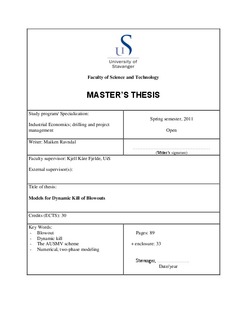| dc.description.abstract | Blowouts represent one of the largest risks oil companies are exposed to during exploration and exploitation of petroleum resources, and the increasing complexity of e.g. drilling operations states the need for more sophisticated well control modeling tools.
Dynamic kill is a technique combining the static head of a kill fluid with frictional pressure losses in order to suppress the reservoir pressure and kill the blowout. The technique can be modeled dynamically with the use of two-phase flow simulators based on conservation equations and closure laws for the different flowing phases. The result is a better understanding of blowout scenarios and parameters like bottom hole pressure, flow rate, pump rate, mud volume and kill fluid density.
In this thesis a transient two-phase model based on the Advection Upstream Splitting Method (AUSMV) scheme has been constructed for the simulation of a dynamic kill. The starting point was a simple two-phase code for gas and liquid extended to a dynamic kill model suitable for oil and liquid. The extension was done through several programming steps: A numerical approach for finding the pressure parameter was implemented and verified, the friction model was changed to suit an oil blowout in a vertical well, a model for the productivity index (PI) was used to simulate the inflow of oil, the velocity of sound for the mixture fluid was changed according to recommendations, and finally a frictional pressure gradient for the relief well was implemented in order to find the required pump pressure for the dynamic kill operation. After running several simulations with different kill rates and observing the results, the model proved to be sufficient in describing a dynamic kill operation for a simplified oil blowout.
The simulations revealed that the model contained a stiff source term, the PI model, switching on/off on a short timescale creating oscillations in the curve. To avoid the oscillations the model required a more sophisticated time integration procedure involving small time steps far below the CFL (Courant-Friedrichs-Lewy) criterion. In addition the blowing well was found to be slightly friction dominated, the increase in friction was larger than the reduction of the hydrostatic pressure when oil displaced water in the well.
Future recommendations for the model include the implementation of several phases and the opportunity to simulate kill fluids with different densities. Wellbore geometries, blowout configurations and models for flow regimes and transitions should also be implemented. This will make the model more versatile for different dynamic kill scenarios in the future. | en_US |
